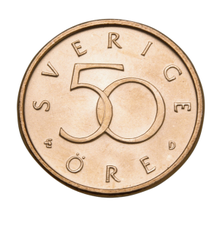Öre
Sweden | |
| Value | 0.5 SEK |
|---|---|
| Mass | 3.7 g |
| Diameter | 18.75 mm |
| Thickness | 1.80 mm |
| Edge | Plain |
| Composition | 97 % copper, 2,5 % zinc and 0,5 % tin |
| Years of minting | 1992–2009 |
| Obverse | |
 | |
| Reverse | |
Öre is the one-hundredth subdivision of the Swedish krona currency unit. The plural and singular are the same in the indefinite forms, whereas the singular definite form is öret and the plural definite form is örena. The name derives from the Latin aureus (gold), the name of a coin worth 25 denarii.[citation needed]
Between 1991 and September 30 2010, the only coin in use with a value below 1 SEK is the 50 öre coin. See the article about the krona for more information. On December 18, 2008, the Swedish Riksbank announced a recommendation to the Swedish government to phase out the final öre coin by 2010[1]. As of March 25, 2009, the coin is no longer minted[2] and it ceased to be legal tender after September 30, 2010. However, until March 31, 2011 it will be possible to redeem the coins at banks.[3] Öre is still legal tender on cards, however.
The corresponding subdivisions of the Norwegian krone and the Danish krone are called øre.
During the middle ages, the öre was a unit of Swedish currency equal to 1/8 of a mark, 3 örtugar or either 24, 36 or 48 penningar (depending on the geographical area in which it was used). It was used as a counting unit for currency already in the 11th century, but was not minted until 1522. This öre was withdrawn in 1776, but returned in 1855 as 1/100 of the riksdaler. The riksdaler was replace by krona in 1873 (one riksdaler equalling one krona in the exchange), but öre remained the name of the subdivision of the currency.
See also
Other coin names that are derived from the gold of which they were once made:
References
- ^ Riksbank urges Sweden to ditch 50 öre coin, The Local, December 18, 2008
- ^ 50-öringens öde avgörs i dag, DN.se, March 25, 2009
- ^ The 50-öre coin will cease to be legal tender after 30 September 2010, Sveriges Riksbank, August 18, 2010
